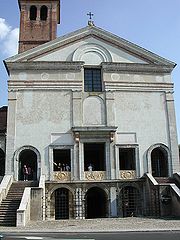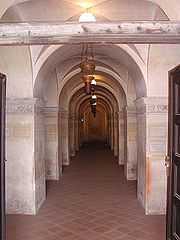
San Sebastiano (Mantua)
Encyclopedia

Mantua
Mantua is a city and comune in Lombardy, Italy and capital of the province of the same name. Mantua's historic power and influence under the Gonzaga family, made it one of the main artistic, cultural and notably musical hubs of Northern Italy and the country as a whole...
, northern Italy
Italy
Italy , officially the Italian Republic languages]] under the European Charter for Regional or Minority Languages. In each of these, Italy's official name is as follows:;;;;;;;;), is a unitary parliamentary republic in South-Central Europe. To the north it borders France, Switzerland, Austria and...
.
Begun in 1460 according to the designs of Leon Battista Alberti, it was left partially completed in the mid 1470s, by which time construction had slowed and was no longer being directed by Alberti. As a consequence, little remains of Alberti’s work apart from the plan, which is considered one of the earliest and most significant examples of Renaissance centrally-planned churches. The plan is in the shape of a Greek cross, with three identical arms centring apse
Apse
In architecture, the apse is a semicircular recess covered with a hemispherical vault or semi-dome...
s, under a central cross-vaulted space without any interior partitions. The church sits on a ground-level crypt
Crypt
In architecture, a crypt is a stone chamber or vault beneath the floor of a burial vault possibly containing sarcophagi, coffins or relics....
which was intended to serve as a mausoleum for the Gonzaga
House of Gonzaga
The Gonzaga family ruled Mantua in Northern Italy from 1328 to 1708.-History:In 1433, Gianfrancesco I assumed the title of Marquis of Mantua, and in 1530 Federico II received the title of Duke of Mantua. In 1531, the family acquired the Duchy of Monferrato through marriage...
family.
The complete absence of columns in the façade signified for Rudolf Wittkower a decisive turning-point in Alberti's interpretation of architecture, moving beyond his statements in De Re Aedificatoria
De Re Aedificatoria
De re aedificatoria is a classic architectural treatise written by Leon Battista Alberti between 1443 and 1452. Although largely dependent on Vitruvius' De architectura, it was the first theoretical book on the subject written in the Italian Renaissance and in 1485 became the first printed book on...
where he considered the column the most noble ornament of building. The façade concealing a narthex
Narthex
The narthex of a church is the entrance or lobby area, located at the end of the nave, at the far end from the church's main altar. Traditionally the narthex was a part of the church building, but was not considered part of the church proper...
that runs the full width of the structure is precisely as wide as its height from the entrance level to the apex of the pediment; it may be fitted with the perfect geometry of the square. The temple front has been converted by Alberti into wall-architecture, as Wittkower noted, and a complete series of pilasters, like pillars embedded in the wall, has been elided to the two outermost, and the two flanking Pellegrino Ardizoni's clumsy doorway, which overlaps them and ill suits its space.

The two outer staircases were added in the twentieth century; prior to 1925 old photographs show the entrance was a single stair to the quattrocento loggia appended to Alberti's design. Wittkower demonstrates that Alberti's plan comprised a set of stairs the full width of the façade leading to five doors (three of which have been filled in as dysfunctional balconies).
The most unexpected motif in the façade is the central break in the entablature presented by the window opening, doubtless intended to be arch-headed under the arched entablature that joins the outer sections, a motif that Wittkower conjectured Alberti knew from the side elevations of the Roman triumphal arch
Triumphal arch
A triumphal arch is a monumental structure in the shape of an archway with one or more arched passageways, often designed to span a road. In its simplest form a triumphal arch consists of two massive piers connected by an arch, crowned with a flat entablature or attic on which a statue might be...
at Orange.

